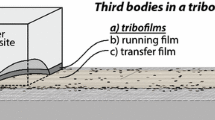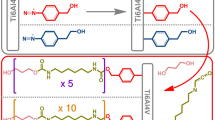Abstract
Polypropylene was implanted with 100 keV titanium and silver ions to fluences of 1, 10 and 50×1019 ions m−2 using a vacuum arc metal-ion source. The implanted specimens were tested for sliding reciprocating wear properties using a nylon counterface, 1 N normal load, 3 mm stroke length and 10000 sliding cycles. The results of the wear tests showed that there was a dramatic improvement in wear properties for the 50×1019 ions m−2 titanium-implanted specimen, to the point that no wear damage was visibly evident after 10000 cycles. A similar wear improvement was not obtained for the lower fluences for titanium implantation or for the silver-implanted specimens. The improvement in wear properties was related to the mechanisms of linear energy transfer from the incident ions to the polypropylene substrate, and consequent effects on cross-linking, which is responsible for changes in properties. The linear energy transfer was quantified using Monte Carlo calculations. In addition, friction coefficient values were also correlated with the wear test results. The significance of high fluences for wear improvements by ion implantation was demonstrated in this study. The investigation showed that metal-ion implantation can be effective in significantly improving wear properties of polymers with a judicious choice of ion type and ion fluence.
Similar content being viewed by others
References
T. Venkatesan, L. Calcagno, B. S. Ellman andG. Foti, in “Ion Beam Modification of Insulators”, edited by P. Mazzoldi and G. W. Arnold (Elsevier, Amsterdam, 1987) pp. 301–379.
E. H. Lee, M. B. Lewis, P. J. Blau andL. K. Mansur,J. Mater. Res. 6 (1991) 610.
E. H. Lee, G. R. Rao andL. K. Mansur,Ibid. 7 (1992) 1900.
G. R. Rao, E. H. Lee andL. K. Mansur, in “Stresses and Mechanical Properties III”, edited by W. D. Nix, J. C. Bravman, E. Arzt and L. B. Freund, Materials Research Society Symposium Proceedings Vol. 239 (Materials Research Society, Pittsburgh, PA, 1992) pp. 189–94.
Idem, Wear,162–164 (1993) 739.
G. R. Rao, K. Monar, E. H. Lee andJ. Treglio,Surf. Coat. Technol., accepted.
I. G. Brown, M. R. Dickinson, J. E. Galvin, X. Godechot andR. A. MacGill,J. Mater. Eng. 13 (1991) 217.
J. F. Ziegler, J. P. Biersack andU. Littmark, “The Stopping and Range of Ions in Solids”, Vol. 1 (Pergamon Press, New York, 1985).
G. R. Rao, E. H. Lee andL. K. Mansur,Wear 174 (1994) 103.
B. Briscoe,Tribol. Int. 14 (1981) 231.
M. Vaziri, R. T. Spurr andF. H. Stott,Wear 122 (1988) 329.
L-H. Lee (ed.) “Polymer Wear and Its Control”, ACS Symposium Series 287 (ACS, Washington, DC, 1981) pp. 27–38.
H. Czichos,Wear 88 (1983) 27.
E. H. Lee, G. R. Rao, M. B. Lewis andL. K. Mansur,J. Mater. Res.,9 (1994) 1043.
Author information
Authors and Affiliations
Rights and permissions
About this article
Cite this article
Rao, G.R., Lee, E.H., Yao, X. et al. Effects of metal-ion implantation on wear properties of polypropylene. J Mater Sci 30, 3903–3908 (1995). https://doi.org/10.1007/BF01153954
Received:
Accepted:
Issue Date:
DOI: https://doi.org/10.1007/BF01153954




